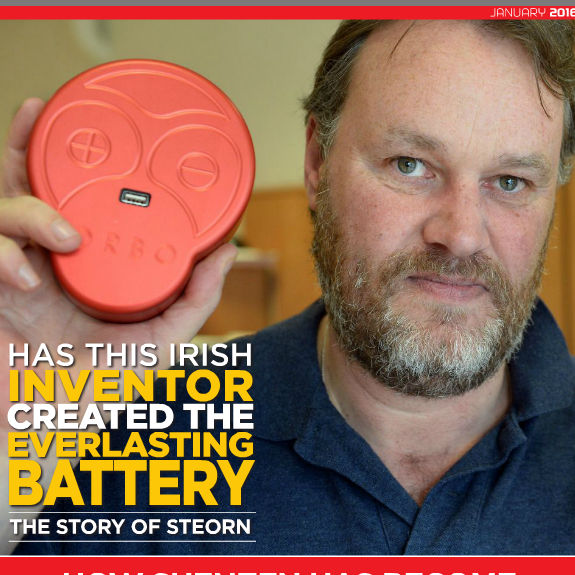
The Irish Times published a lengthy article about Steorn yesterday, featuring an interview with CEO Shaun McCarthy and accompanied by a seven minute video in which Shaun takes reporter Mark Hillard on a tour of Steorn’s facilities. The Irish Times piece is a trimmed down version of the full article, which was the cover story of the latest issue of Irish Times Innovation magazine.
While the story doesn’t cover much new ground, it does present to a mainstream audience an interesting and comprehensive summary of where Steorn stands now, as it’s preparing to release its first Orbo-powered products. The story’s companion video also gives us the best look we’ve had yet of Steorn’s offices and workshops.
Below are some highlights from the interview with Shaun McCarthy.
McCarthy reiterates Steorn’s purpose in releasing products themselves: they hope to prove the technology not by convincing scientists, but by letting consumers find out from first hand experience that it works:
This is in many ways a self-resolving controversy. If someone sits that on their desk and it works for a month it is a very good battery. If it works for two months it’s bordering on magic. If it works for three months it is magic.
Later, McCarthy gives a bit more detail on the principle they believe underlies Orbo’s ability to generate energy:
What we found is that we could speed up and slow down electromagnetic fields which traditionally should travel at the speed of light. When we did that we got these energy anomalies… So I suppose you could take a view, which we are not qualified to make [scientifically], but if you ask our guys what we really think we are doing, we think that we are converting time into energy. Which sounds very grandiose when you see three strips of metal and two wires! But that’s the engineering principle we’ve applied to it.
McCarthy has stated in the past that he believes that the Orbo effect involves “splitting time”, and that they are “using the differences in the magnetic fields to manipulate time and that is leading to the creation of energy.” Here he adds a bit more detail, asserting that time itself may somehow be getting converted into energy. But at the same time, he makes it clear that Steorn does not fully understand the science behind what they’re doing; they only understand enough to exploit the effect.

A workbench at Steorn with vials full of chemicals that have previously been shown as electret material.
Claims of manipulating time are highly dubious, of course, but perhaps no more dubious than claims of generating energy from nothing. When it comes to those who believe Steorn is perpetrating a fraud, a long con to separate investors from their money, McCarthy is sympathetic to the reasoning behind their point of view:
You have this logic trap, okay, what we’re claiming is clearly impossible. They are clearly not idiots; therefore it must be a con. It must be a fraud. Or it is something else; it’s a viral marketing campaign. I think after 15 years, a viral marketing campaign is probably not realistic. Therefore if we apply Occam’s Razor, straight logic, clearly it’s a fraud! Again the logic is quite compelling.

A basement workshop at Steon HQ, showing the small studio set where parts of last year’s webinars were filmed.
McCarthy also raises the possibility that Orbo is not generating energy from nothing, but perhaps is harvesting “dark energy” instead:
As to is it really contravening any laws of physics, there is bigger questions there. All that we can say is it’s not degrading or drawing on any known energy source but then there are vast swathes of energy that we call dark energy in scientific terms. This could just be capturing that and then it really wouldn’t be the heresy that it appears on face value.
The story quotes from several scientific detractors, including Michio Kaku (from his 2006 ABC News interview) and Luke Drury, a physicist at the Dublin Institute for Advanced Studies. Drury raises the usual scientific objections that Steorn’s claims are impossible, and also counter’s McCarthy’s speculation that Orbo is harvesting dark energy:
Even if one could make such a coupling, the absolute energy content in the dark sector is very low and it would be like trying to power a smart-phone from starlight.
According to the story, Steorn’s initial sales figures will be reported at the end of the first quarter of 2016. This seems to contradict a statement made on Steorn’s Facebook page last week that they will release initial figures at the end of January. Note however that the video interview took place in late December, so the Facebook statement is the more recent.
One area where the article gets a point slightly wrong is in discussing perpetual motion machines. The story states, “Explaining his own technology, McCarthy dismisses previous suggestions they are claiming to have developed a perpetual motion machine (a hypothetical device that works indefinitely without an apparent energy source) as there is no moving parts.” This is true in that the current iteration of Orbo is a solid-state device, but in fact Steorn did claim to develop (and attempt to demonstrate) a perpetual motion machine several years ago, as an early version of the Orbo technology. So it’s not quite accurate to say that McCarthy was “dismissing previous suggestions” that they are claiming to have a perpetual motion machine; actually McCarthy was just clarifying that their current product does not involve any motion, perpetual or otherwise.
The video ends with the caption, “The Irish Times will test the Orbo Cube in 2016.”
This is the beginning of what may be a wave of mainstream media coverage of Steorn as their first Orbo products are expected to ship in the next few days.


